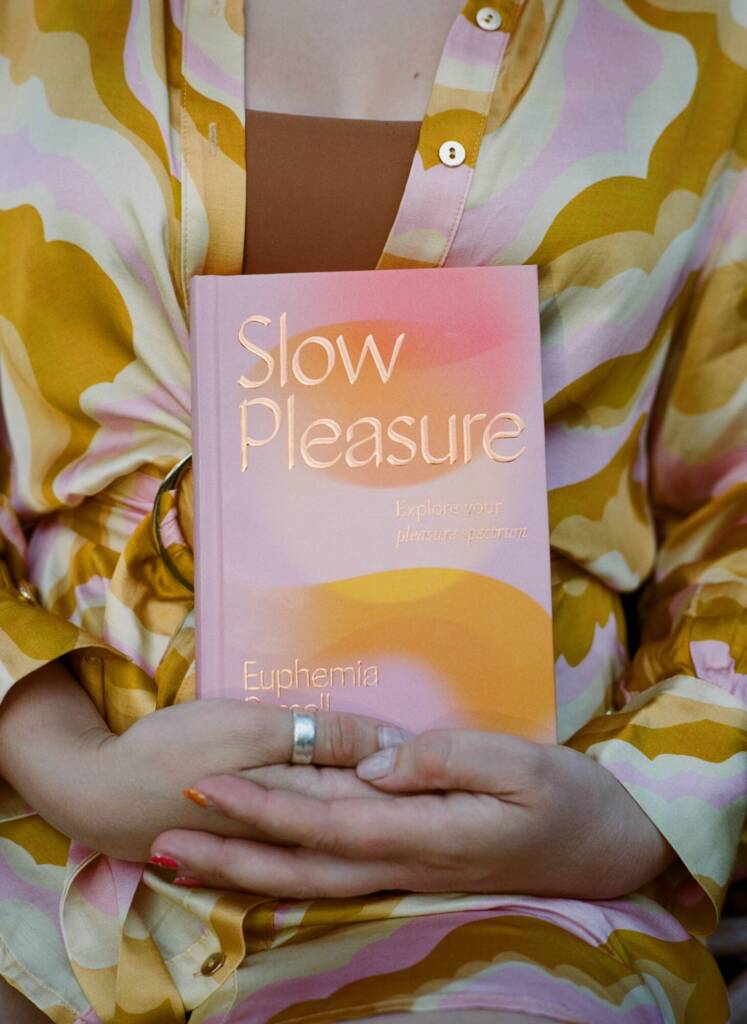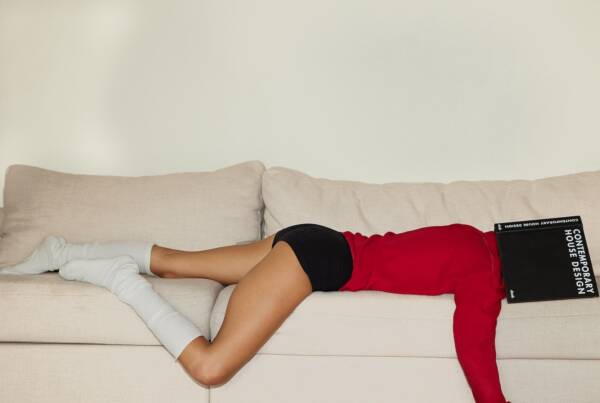Extract from Euphemia Russell’s book Slow Pleasure
 This is an edited extract from Slow Pleasure: Explore Your Pleasure Spectrum by Euphemia Russell, published by Hardie Grant Books, RRP $29.99, available in-stores nationally.
This is an edited extract from Slow Pleasure: Explore Your Pleasure Spectrum by Euphemia Russell, published by Hardie Grant Books, RRP $29.99, available in-stores nationally.
Practices to welcome more pleasure and presence
Body-focused exercises and practice can build our resilience, helping us weather the ups and downs of our moods, states and experiences. They can also build our capacity for awareness and therefore become scaffolding for our pleasure. They can help us to feel more connected to ourselves and the world around us. As my dear friend and somatic peer Jo Buick says, embodiment practices are a way to liquify, soften or welcome more fluidity into ourselves. When we encourage movement and flow to our breath, thoughts, feelings and sensations, we increase our potential for presence and pleasure.
These practices can also be done with friends, family or lovers to generate communal collective care and connection.
It’s important that we’re tender and supportive with ourselves as we do practices to shift our state. Many of our bodily and emotional reactions emerged from previous actions and desires for safety, belonging and dignity, which is incredibly wise of the body, but might not be helpful any longer or the only way for us to respond now.
On a physiological level, when we’re in a calm and connected state, our adrenaline and cortisol, the hormones for activating states, are lower. This allows a decrease of heart rate and an overall relaxation of the body, allowing secondary functions that aren’t essential in a moment of survival to kick in. These functions are digestion, immune function, and when it comes to sex and pleasure, functions such as erections and lubrication.
It is important to remember that the ideal of wellness or health is not being calm, grounded and centred all the time.
Exercises to shift your state
I call these exercises the transcendental fundamentals because they help us to shift states in a simple, accessible way. They can be done for only one minute and still make a difference. Learning to do these exercises in moments you want to transition will help you decide whether to allow your current state to shift or persist. States can be very fluid, but sometimes we find ourselves stuck in a state, feeling like we don’t have tools or options to shift it. I do some of these nearly every day and they are deeply life changing, and state changing.
Shifting states can be as simple as waking up, going to sleep, beginning or finishing work, shifting to an intimate moment with a friend or lover, or taking a break.
Not all people have the same response to the same actions, so see what works for you and how that response can be fluid day-to-day. Build a fun toy kit of exercises, so you have a variety of options to choose from.
You can do these exercises anywhere – in a cubicle, at home, in the car – whatever suits your lifestyle and needs best.
I have so many of these dorky movement practices that I love to incorporate into my daily life. Try them out and see which ones feel supportive for you.
Note: most of us tend to feel safer when we’re upright and standing, but if you prefer, you can do these sitting or lying down if you wish.
Set a timer if an exercise feels hard or overwhelming at first. Allow yourself to stop after a minute if you want to then reassess and do it for longer if it feels helpful or pleasurable.
One-minute soothing practices
What soothes a baby often soothes an adult so you can keep it simple. Soothing-focused practices can help metabolise some of the hormones that make you feel ‘locked in’ to your body, or like a rocket wanting to take off because you’re feeling worried, nervous, stressed, angry, or any overwhelmingly intense experience. Scientifically put, they help metabolise the stress hormones cortisol and adrenaline. Try these and see what works for you. I also encourage you to find other practices that help soothe you.
- Stroke your hair and head. Really tune into the sensation and how it feels. Stroke yourself like you would a dog or cat. What intensity and pace do you want? Do you want nails, fingers or a flat palm?
- Put a flat palm on your forehead and/or solar plexus (where the ribs meet the stomach). Hold both places and try to soften your body more with each breath.
- Hug yourself. Really let yourself soften into being held.
- Butterfly hold. Cross your arms and put your hands in your armpits and breathe to soften into the position.
- Stroke your limbs. Brush down in short or long strokes at a rhythm that feels best.
- Shake and shimmy. Start by shimmying your shoulders and shaking your hips, then build up to a full-on tantrum, flopping all your limbs everywhere, like a wet dog shaking itself off.
- Flutter your lips with a ‘brrrr’ like a horse. This helps to soften your jaw and throat, and to release extra tension.
- Forward fold. Flop forward, bend your knees softly, and sway upside down.
- Shimmy and massage your jaw. Open your mouth and relax your jaw. Gently move it back and forward, and side to side. Let sound escape, or a yawn, if there is one there.
- Do repetitive and predictable actions at a slow pace. Such as baking, brushing your hair, moisturising your legs.
- Imagine unfurling your brain muscle. Imagine your brain relaxing and unfurling like a tight fist slowly releasing each finger until the hand is open.
- Do something with your hands. Use fine motor skills by doing things such as puzzles, plaiting or Lego to busy your hands and quieten your mind.
- Breathe deeper into your stomach. This is not always possible as the first practice. When we feel locked in and tense, it can be hard to breathe into our stomachs. Try one of the other practices listed here first, then try deeper breathing.
- Make noise. Sing, belt out power ballads in the car, hum, open your mouth and allow any vowel sound to emerge, make the sound ‘vuuu’ for the length of a breath and repeat in rounds.
- Play music. Play music that will soothe you and help you shift your state.
One-minute enlivening practices
These can help if you’re feeling generally or specifically flat or low energy, and want to enliven yourself. They help you to generate more energy, and healthy activation (not all activation is bad). Many people can feel flat, tired and sleepy in response to stress, and these can help shift that state. These really help enliven me, and create the energy I need to begin or do particular actions I need to rouse myself for.
- Tense and contract your muscles. One by one – your fists, butt, then legs, or all at the same time. Then release. Do three rounds, then repeat if you like.
- Whole body push. Push your arms against a wall, like you’re in a vertical plank. Tense your whole body and lean into the motion.
- Thumb trumpet. Put your thumb in your mouth, then blow out like blowing up a balloon, but don’t let any air escape. Let your cheeks and stomach push out. Release air when you need to breathe.
- Gently bounce. Either sitting or standing. Build up speed and intensity if it feels manageable and energising.
- Lovingly pat down your body. Start rhythmically and gently with your limbs, bringing awareness and activation to your limbs and body parts.
- Stamp your feet, or play the drums with your hands. Find the rhythm that feels best, perhaps it’s to the beat of a song.
- Sway. Begin swaying, and slowly bring in more movement. Imagine yourself like seaweed or a tree, rooted in your feet or pelvis but with flexibility and motion. Try making the movements more and less controlled. Explore swaying back and forth, and side to side.
- Microthrust. Clench with your pelvic floor muscle. Then, with your pelvis, thrust and tilt your hips up and down. Do as small and controlled an action as you can.
- Do micro and macro circle rotations. Explore circling the hips, shoulders and any other body part.
- Make sound. Choose a body part that might feel numb or flat, and start making sound from that place. Open your mouth and see what sounds emerge. This doesn’t need to be loud or to be singing, just let noise be released without trying to perform too much.
- Shout. If you’re worried about noise then shout into a pillow, inside a car or under water.
- Put on music. Let it represent the kind of mood or state you’d like to shift to.
- Do three strength moves. Perhaps one push-up, one sit-up and one squat. Anything that engages the core and the thighs is great. How do you feel after doing three? Do more if you want to.
- Bend knees, engage thighs, adopt a wide stance and shout ‘HUH’. This can help us activate our core and our centre, and build dignity and sense of self.
- Explore your length. See if you can sit or stand taller. How does that shift your mental, emotional and physical states?
Integration questions
- Which three tools would be helpful for you to write down and keep in hand for when you want to feel soothed?
- Which three tools would be helpful for you to write down and keep in hand for when you want to feel enlivened?
- What practices would you add to this list for yourself?






